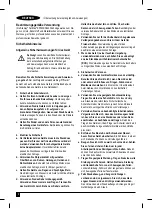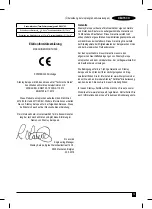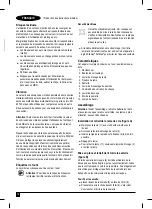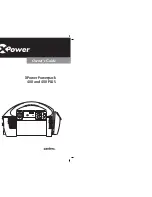
4
ENGLISH
(Original instructions)
e. Maintain power tools. Check for misalignment or
binding of moving parts, breakage of parts and any
other condition that may affect the power tools
operation. If damaged, have the power tool repaired
before use.
Many accidents are caused by poorly
maintained power tools.
f. Keep cutting tools sharp and clean.
Properly
maintained cutting tools with sharp cutting edges are less
likely to bind and are easier to control.
g. Use the power tool, accessories and tool bits etc. in
accordance with these instructions, taking into
account the working conditions and the work to be
performed.
Use of the power tool for operations different
from those intended could result in a hazardous situation.
5. Service
a. Have your power tool serviced by a quali
fi
ed repair
person using only identical replacement parts.
This will
ensure that the safety of the power tool is maintained.
Additional power tool safety warnings
@
Warning!
Additional safety warnings for jigsaws
and reciprocating saws
Hold power tool by insulated gripping surfaces, when
performing an operation where the cutting accessory
may contact hidden wiring or its own cord.
Cutting ac-
cessory contacting a “live” wire may make exposed metal
parts of the power tool “live” and could give the operator
an electric shock.
Use clamps or another practical way to secure and
support the workpiece to a stable platform.
Holding the
work by hand or against your body leaves it unstable and
may lead to loss of control.
Keep hands away from cutting area.
Never reach
underneath the work piece any reason. Do not insert
fi
ngers or thumb into the vicinity of the reciprocating blade
and blade clamp. Do not stabilize the saw by gripping the
shoe.
Keep blades sharp.
Dull or damaged blades may cause
the saw to swerve or stall under pressure. Always use the
appropriate type of saw blade for the workpiece material
and type of cut.
When cutting pipe or conduit, make sure that they are
free from water, electrical wiring, etc.
Do not touch the workpiece or the blade immediately
after operating the tool.
They can become very hot.
Be aware of hidden hazards, before cutting into walls,
fl
oors or ceilings, check for the location of wiring and
pipes.
The blade will continue to move after releasing the
switch.
Always switch the tool off and wait for the saw
blade to come to a complete standstill before putting the
tool down.
Warning!
Contact with, or inhalation of dusts arising from cut-
ting applications may endanger the health of the operator and
possible bystanders. Wear a dust mask speci
fi
cally designed
for protection against dust and fumes and ensure that persons
within or entering the work area are also protected.
The intended use is described in this instruction manual.
The use of any accessory or attachment or performance
of any operation with this tool other than those recom-
mended in this instruction manual may present a risk of
personal injury and/or damage to property.
Safety of others
This tool is not intended for use by persons (including
children) with reduced physical, sensory or mental capa-
bilities, or lack of experience and knowledge, unless they
have been given supervision or instruction concerning use
of the appliance by a person responsible for their safety.
Children should be supervised to ensure that they do not
play with the appliance.
Residual risks.
Additional residual risks may arise when using the tool which
may not be included in the enclosed safety warnings. These
risks can arise from misuse, prolonged use etc.
Even with the application of the relevant safety regulations
and the implementation of safety devices, certain residual
risks can not be avoided. These include:
Injuries caused by touching any rotating/moving parts.
Injuries caused when changing any parts, blades or ac-
cessories.
Injuries caused by prolonged use of a tool. When using
any tool for prolonged periods ensure you take regular
breaks.
Impairment of hearing.
Health hazards caused by breathing dust developed when
using your tool (example:- working with wood, especially
oak, beech and MDF.)
Vibration
The declared vibration emission values stated in the technical
data and the declaration of conformity have been measured
in accordance with a standard test method provided by
EN 60745 and may be used for comparing one tool with
another. The declared vibration emission value may also be
used in a preliminary assessment of exposure.
Summary of Contents for FATMAX KFFMES340
Page 1: ...www stanley eu KFFMES340 7 8...
Page 2: ...2 A B E F C D 8...
Page 64: ...64 Stanley Fat Max KFFMES340 1 a b c 2 a b c d e f RCD RCD 3 a b c OFF d...
Page 65: ...65 e f g 4 a b c d e f g 5 a...
Page 66: ...66 MDF EN 60745 2002 44 E Stanley FatMax...
Page 68: ...68 6 5 0 0 6 5 F 8 0 1 2 3 0 1 2 3 LED LED 10 LED 10 1 1 5 PVC Stanley FatMax U T...
Page 78: ...78 POLSKI...
Page 92: ...92 Stanley FatMax KFFMES340 1 a b c 2 a b c d e f 3 a b c...
Page 93: ...93 d e f g 4 a b c d e f g 5 a...
Page 94: ...94 EN 60745 2002 44 EC...
Page 95: ...95 Stanley FatMax 1 2 3 4 5 6 7 8 9 10 A 11 3 4 11 3 B 9 5 9 9 5 C 1 2 7 D E 45 6 5 0...
Page 96: ...96 6 5 15 30 45 6 5 0 0 6 5 F 8 0 1 2 3 0 1 2 3 10 10 1 1 5 Stanley FatMax U T...
Page 100: ...4...
Page 102: ...STANLEY 586 8 67 1 D n n n nu no n n n n m n ma a u u u u...
Page 103: ......
Page 104: ...N602897 REV01 07 2018...





































